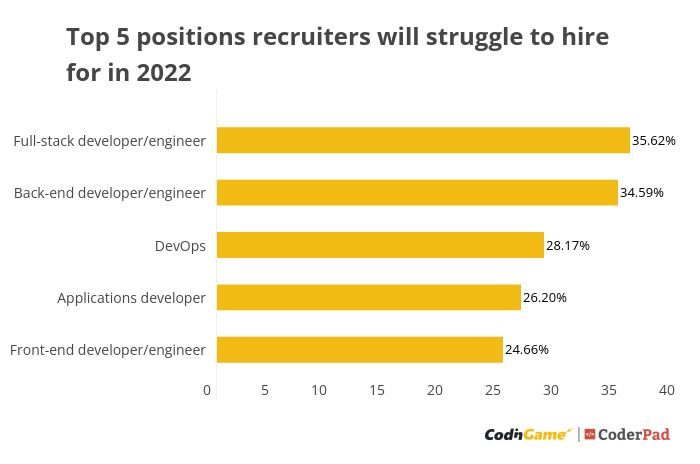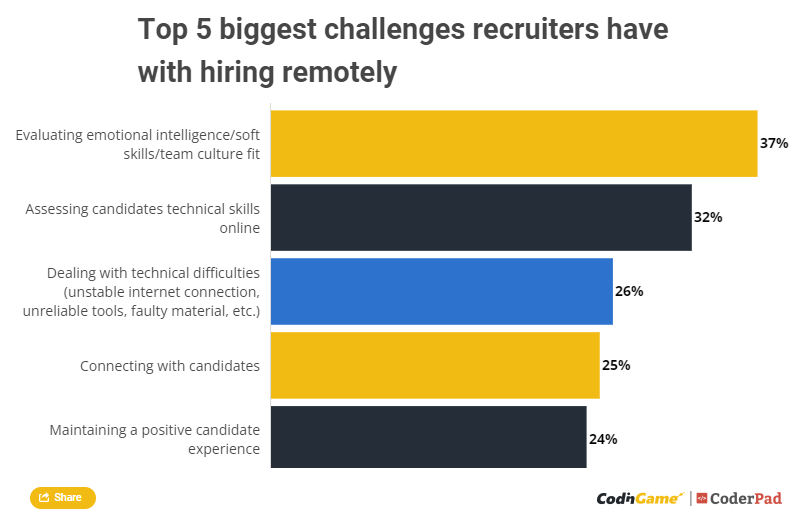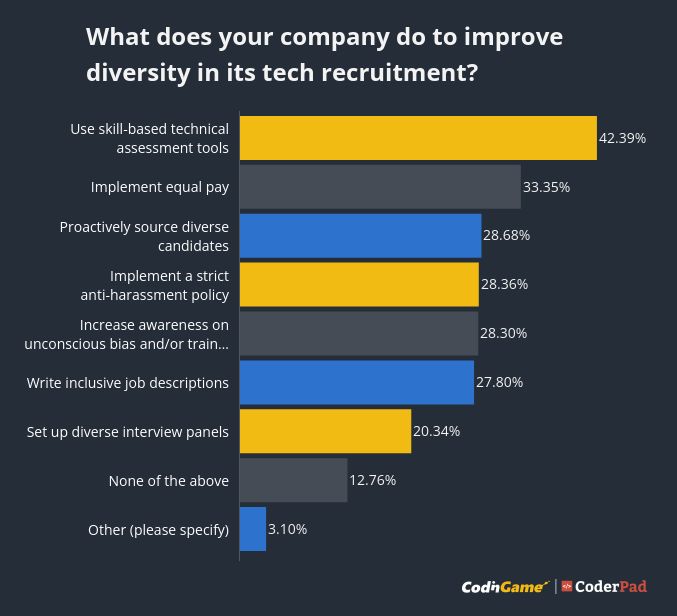Introduction
The tech job market is changing. The pandemic has impacted the landscape in several ways and savvy recruiters need to stay on top of the trends to ensure they can keep their current employees happy and fill new posts.
We surveyed 14,000 tech recruiters and developers in our CodinGame & CoderPad 2022 Global Tech Hiring Survey to gain a deep insight into the tech recruitment market this coming year. Here we compile some of the main trends revealed from our data that can help you strategize for a successful year.
1. It’s a job candidate’s market
In 2021 the tech job market was already tight. There were more job openings published than candidates available. 2022 will not be any easier for tech recruiters.
The pandemic’s effect on supply and demand
The pandemic has affected supply and demand in two main ways. First, the need for every company to go online in the face of lockdowns and other restrictions created a greater demand for developers across industries. Some of the larger employers also increased hiring. Indeed, during the pandemic in 2020, Facebook announced they would hire 10,000 additional product and engineering staff members and Amazon announced they would hire even more than that.
Second, the pandemic has had an effect on the number of new developers being trained. In 2020, for example, the number of developers increased by 2.5% instead of a predicted 4%. More companies need developers and the growth in the supply has slowed, a perfect scenario to tip the balance in favor of developers.
Recruiters’ have more money to recruit developers
53% of our recruiter survey respondents reported that their budget for hiring developers is going up in 2022. While increasing budgets likely reflect greater recruitment needs, some recruiters mentioned a need to offer higher salaries to keep up with demand.
There is also an increase in mass hiring. The percentage of survey respondents planning to hire 201-500 developers has more than doubled compared to the 2021 survey.

A struggle to hire for many positions
Recruiters believe they will struggle to recruit for a variety of positions. Topping the list are full-stack and back-end developers, despite these positions also being the most commonly held among developer survey respondents. In some cases there is clearly a lack of candidates in certain areas. For example, 26% of recruiters want to hire for Angular 2+ knowledge in 2022, only 17% of developers who responded knew this framework. 28% of recruiters believe they will struggle to recruit for DevOps positions in 2022 and it’s true only 2.5% of survey respondents currently hold this position. Fortunately, developers are up on trends and 25% said they would like to learn DevOps in 2022 but this will not solve the immediate shortage.
2. Recruiters casting a wider net to fill posts
As the market tightens, recruiters are updating their criteria to widen the pool. It’s no longer practical to filter too strictly and leave candidates with excellent potential by the wayside. There is a need to focus on the criteria which matter the most. “Finding qualified candidates” is the number one challenge recruiters face in 2022.
More openness to hiring outside the university or engineering school
One area in which recruiters are becoming more supple is their recruiting of developers who learnt to code outside of a university or engineering school, such as those who are self-taught or who learnt from a boot camp, MOOC, short-term training course, etc. The percentage of recruiters who hire from this pool has increased from 23% to 39% in just one year.
This greatly widens the talent pool. Only 43% of developers who responded to our survey learned to code in a university or engineering school. 32% were self-taught, learning from free online and offline resources, such as tutorials, books, YouTube, etc.
Hiring from a range of backgrounds can add challenges. Recruiters reported “identifying potential even if candidates don’t have the perfect matching skillset” as their second biggest challenge when recruiting developers (following “finding qualified candidates”). Fortunately, there is the option of using skills assessment tools, which go beyond merely testing coding, to help identify potential. CodinGame Assessment, for example, allows you to evaluate not only language knowledge but also other skills, such as problem solving, code reliability, and design. This greater breadth of insight can reveal potential that other assessments would miss.
Imagining a hiring process without CVs
58% of recruiters are open to the idea of ditching the CV to instead base hiring decisions on technical assessment tests, live interviews, etc. They recognize that it is an imperfect measure, which lacks objectivity. Two CVs could list the same proficiency in a coding language when the skills of the two candidates are vastly different. There is also the problem of bias being introduced when there is additional data that may or may not be relevant to the actual post.
Using technical assessment earlier in the hiring process can make the process more efficient and fair and take out all the guesswork involved with evaluating candidates by CV.
Searching for talent abroad
A third area in which recruiters are becoming more flexible is in the geographical area wherein they will seek candidates. 40% are now open to recruiting globally, compared to 35% in 2021. Undoubtedly the proliferation of remote work and hybrid teams during these past few years has had an impact.
Many developers are also searching for jobs over a wider area. In 2020 only 35% of developers said they would look for new job opportunities internationally but for 2022 the number has risen to 49%. These developers want to work remotely, 33% of respondents would prefer to work 100% remotely and 59% part-remote and part in the office. Only 4% said they would prefer to be in the office 100% of the time.
When companies offer 100% remote positions, the talent pool widens greatly. This can be a boon to any company but especially those who might find it difficult to compete on salaries in the local market.
3. How recruiters are competing for technical talent
Candidate experience a priority
In such a tight job market, recruiters need to do what they can to ensure they find and attract the best talent. Providing a great experience can make the difference between a potential recruit accepting an offer or not. LinkedIn reports 83% of candidates can change their mind about a role or company they once liked if they have a poor candidate experience. It’s therefore no surprise that recruiters chose “candidate experience” as the number one thing their company will invest in/develop in 2022.

Remote recruiting with the right tools
The increase in recruiting remotely means that there are new challenges and opportunities for recruiters to provide a great candidate experience. Both recruiters and developers listed “dealing with technical difficulties (unstable internet connection, unreliable tools, faulty material, etc.)” as a major issue with remote recruiting. Hiccups can make a remote interview a stressful experience. Issues often arise when trying to use tools which aren’t perfectly adapted to a coding interview.
Developers described issues such as trying to do a coding interview using Teams when they have Linux installed. Using a seamless browser-based tool is a good way around this. Interviews might take place at lunchtime or in a break on a borrowed laptop which doesn’t have the developers preferred coding tool. Using a tool perfectly adapted to this process, such as browser-based CoderPad, is one solution to ensure a smooth candidate experience.
Choosing the best assessment method (definitely not the whiteboard interview)
Assessing candidates’ technical skills is an essential part of the hiring process. Recruiters need to balance the need to assess candidates with providing a great experience. Whiteboard or pen and paper assessments are universally disliked. One potential opportunity is by using more gamified testing, which developers rated significantly above theoretical testing.
28% of recruiters listed “identifying potential even if candidates don’t have the perfect matching skillset” as one of their top challenges and technical assessment towards the beginning of the hiring process can solve this.
Standing out as a potential employer
23% of recruiters listed “standing out from other companies to attract talent” as a challenge when recruiting developers, bringing it into third place. Indeed, with bigger companies snapping up talent, it can be hard for many smaller or lesser known companies to compete. Fortunately there are opportunities to compete on factors other than salary or reputation. Companies can work hard to tackle the factors developers list as their biggest challenges at work, such as:
- “rework, changes, unplanned work, unplanned problems”
- “unclear direction”
- “unrealistic deadlines”
- “inadequate or insufficient work tools”
By working on company culture, organization and project management, companies can become more attractive to developers who have suffered from these issues in the past. Other opportunities are to offer more flexibility, greater decision making abilities and the possibility to work remotely. The latter is essential if a company wants to attract developers, excluding this option is potentially excluding a third of the talent pool who would prefer a 100% remote post.
4. Improving diversity an opportunity for everyone
Bias an issue
65% of recruiters agree that bias is an issue in tech recruiting. Unconscious bias leads to less diversity. Diversity benefits companies in various ways, including benefitting innovation, problem-solving, and profitability. In addition, it’s also not feasible to ignore a large portion of the talent pool in such a tight job market.
Diversity: good for the company and attractive to potential employees
In addition to the benefits for the company and the access to a wider talent pool, there is also another benefit to embracing diversity. In a 2021 Beqom survey, 48% of respondents said they would consider moving to another company if it had a well-developed Diversity, Equity and Inclusion (DEI) policy. This can be especially important for millennials. According to a Deloitte survey, 83% of whom feel empowered and engaged in the workplace when they believe their company fosters an authentically inclusive culture.

Skill-based hiring: the remedy for bias
Recruiters listed “using skill-based technical assessment tools” as their number one way to improve diversity in tech recruitment. This ensures that they hire based on talent rather than on assumptions based on mental shortcuts, such as assuming the developer who attended one well-known university can code better than another who attended a smaller school. It can also reduce the chance of mistakenly hiring the person who overrates their abilities over the more modest person who rates their abilities lower.
Companies can go further and anonymize applications or test reports to hide applicant details, such as gender and ethnicity, until the point of the interview. This can easily be achieved by combining CodinGame Assessment with your ATS. The perfect way to reduce bias in hiring while running fair and accurate assessments and providing a great candidate experience.
5. Retention: how to hold onto employees during the Great Resignation
Along with the tight job market, another challenge facing companies is the Great Resignation. Many employees are changing jobs, with resignations increasing by 4.5% in the tech industry. The tumultuous period we’ve been experiencing worldwide has many people reconsidering what they want from a job and has been a catalyst for many to start looking elsewhere. Fortunately, a strategic employer can hold onto current employees if they focus on the aspects which matter most to them.
Streamlining processes to eliminate friction for developers
Just below “candidate experience”, recruiters listed “talent retention” in second place as something they would be investing in or developing in 2022. Some opportunities to retain current employees overlap with those mentioned to attract new recruits. This includes working on the challenges mentioned by developers, such as “Rework, changes, unplanned work, unplanned problems”, “Unclear direction”, “unrealistic deadlines” and “inadequate or insufficient work tools”.
Internal mobility to keep developers interested and fill hiring gaps
Another opportunity involves giving current employees an opportunity to evolve and grow in the company. This can include offering opportunities for upskilling and reskilling. 49% of recruiters said their companies were involved in reskilling and 66% in upskilling. Both provide the opportunity for internal mobility, with reskilling also providing a way to solve recruiting struggles.

Fostering hybrid teams for flexibility and productivity
With the increased desire to work remotely, organizing teams in a hybrid manner offers a further opportunity for companies. 51% of recruiters believe that hybrid team organization has a positive effect on work quality and productivity. We also see a steep difference in satisfaction between developers who have are still able to work 100% remote and those who’ve been asked to return to the office following pandemic-related remote work. 67% of those still working from home are “happy” or “very happy” and only 36% of those back in the office full-time.
Developers also find that dividing a team between onsite and remote doesn’t have a negative effect on output. Companies can work to create a culture where everybody feels heard and appreciated, to prevent inequality where those present are advantaged for promotion or other opportunities.
Conclusion
While market changes can make recruiting more challenging, the opportunities are there for anyone who adapts strategies in line with trends.
To learn more about results from our 2022 Global Tech Hiring survey, check out our detailed report here.

